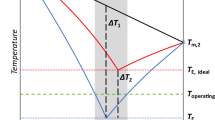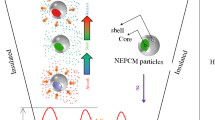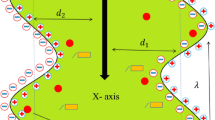Abstract
Numeric simulation of the pervaporation process is carried out using molecular dynamics. Various conditions of the separation of an ideal binary Lennard-Jones mixture using a crystalline membrane are considered. Components of separated mixtures differ in regards to the energy of interaction with molecules of the membrane. As a result of simulation, fields of concentrations and densities along the cell, as well as flux values of components, are obtained. In addition, coefficients of the diffusion of components in the membrane are computed. It is shown that the correspondence of numeric simulation data to macroscopic mass transfer equations are observed in all cases. It can be concluded that the behavior of molecules in a nonequilibrium system with a scale of several dozens of molecule diameters corresponds to transfer equations of linear nonequilibrium thermodynamics. Results of numeric simulation show the selectivity of a membrane in regard to the component with a larger interaction energy. It is shown that molecular simulation is able to predict the main characteristics of membrane separation (fluxes, selectivity, adsorption, and diffusion coefficients).








Similar content being viewed by others
REFERENCES
Bell, C.M., Gerner, F.J., and Strathmann, H., Selection of polymers for pervaporation membranes, J. Membr. Sci., 1988, vol. 36, pp. 315–329. https://doi.org/10.1016/0376-7388(88)80025-5
Kagramanov, G.G. and Farnosova, E.N., Scientific and engineering principles of membrane gas separation systems development, Theor. Found. Chem. Eng., 2017, vol. 51, no. 1, pp. 38–44. https://doi.org/10.1134/S0040579517010092
Akberov, R.R., Fazlyev, A.R., Klinov, A.V., Malygin, A.V., Farakhov, M.I., Maryakhina, V.A., and Kirichenko, S.M., Dehydration of diethylene glycol by pervaporation using HybSi ceramic membranes, Theor. Found. Chem. Eng., 2014, vol. 48, no. 5, pp. 650–655. https://doi.org/10.1134/S0040579514030014
Babak, V.N., Didenko, L.P., Kvurt, Y.P., and Sementsova, L.A., The recovery of hydrogen from binary gas mixtures using a membrane module based on a palladium foil taking into account the deactivation of the membrane, Theor. Found. Chem. Eng., 2018, vol. 52, no. 3, pp. 371–385. https://doi.org/10.1134/S0040579518020021
Babak, V.N., Didenko, L.P., Kvurt, Yu.P., and Sementsova, L.A., Studying the operation of a membrane module based on palladium foil at high temperatures, Theor. Found. Chem. Eng., 2018, vol. 52, no. 2, pp. 181–194. https://doi.org/10.1134/S004057951802001X
Wijmans, J.G. and Baker, R.W., The solution-diffusion model: A review, J. Membr. Sci., 1995, vol. 107, nos. 1–2, pp. 1–21. https://doi.org/10.1016/0376-7388(95)00102-I
Krishna, R., Diffusion in porous crystalline materials, Chem. Soc. Rev., 2012, vol. 41, no. 8, pp. 3099–3118. https://doi.org/10.1039/C2CS15284C
Oulebsir, F., Vermorel, R., and Galliero, G., Diffusion of supercritical fluids through single-layer nanoporous solids: Theory and molecular simulations, Langmuir, 2018, vol. 34, no. 2, pp. 561–571. https://doi.org/10.1021/acs.langmuir.7b03486
Hinkle, K., Wang, X., Gu, X., Jameson, C., and Murad, S., Computational molecular modeling of transport processes in nanoporous membranes, Processes, 2018, vol. 6, no. 8, p. 124. https://doi.org/10.3390/pr6080124
Wang, L., Dumont, R.S., and Dickson, J.M., Nonequilibrium molecular dynamics simulation for studying the effect of pressure difference and periodic boundary conditions on water transport through a CNT membrane, Mol. Phys., 2017, vol. 115, no. 8, pp. 981–990. https://doi.org/10.1080/00268976.2017.1298862
MacElroy, J.M.D., Computer simulation of diffusion within and through membranes using nonequilibrium molecular dynamics, Korean J. Chem. Eng., 2000, vol. 17, no. 2, pp. 129–142. https://doi.org/10.1007/BF02707134
Cao, W., Tow, G.M., Lu, L., Huang, L., and Lu, X., Diffusion of CO2/CH4 confined in narrow carbon nanotube bundles, Mol. Phys., 2016, vol. 114, nos. 16–17, pp. 2530–2540. https://doi.org/10.1080/00268976.2016.1177665
Richard, R., Anthony, S., and Aziz, G., Pressure-driven molecular dynamics simulations of water transport through a hydrophilic nanochannel, Mol. Phys., 2016, vol. 114, no. 18, pp. 2655–2663. https://doi.org/10.1080/00268976.2016.1170219
Heffelfinger, G.S. and van Swol, F., Diffusion in Lennard-Jones fluids using dual control volume grand canonical molecular dynamics simulation (DCV-GCMD), J. Chem. Phys., 1994, vol. 100, no. 10, pp. 7548–7552. https://doi.org/10.1063/1.466849
Firouzi, M. and Sahimi, M., Molecular dynamics simulation of transport and separation of carbon dioxide-alkane mixtures in a nanoporous membrane under sub- and supercritical conditions, Transp. Porous Media, 2016, vol. 115, no. 3, pp. 495–518. https://doi.org/10.1007/s11242-016-0638-6
Arya, G., Chang, H.-C., and Maginn, E.J., A critical comparison of equilibrium, non-equilibrium and boundary-driven molecular dynamics techniques for studying transport in microporous materials, J. Chem. Phys., 2001, vol. 115, no. 17, pp. 8112–8124. https://doi.org/10.1063/1.1407002
Cracknell, R.F., Nicholson, D., and Quirke, N., Direct molecular dynamics simulation of flow down a chemical potential gradient in a slit-shaped micropore, Phys. Rev. Lett., 1995, vol. 74, no. 13, pp. 2463–2466. https://doi.org/10.1103/PhysRevLett.74.2463
Thompson, A.P., Ford, D.M., and Heffelfinger, G.S., Direct molecular simulation of gradient-driven diffusion, J. Chem. Phys., 1998, vol. 109, no. 15, pp. 6406–6414. https://doi.org/10.1063/1.477284
Kazemi, M. and Takbiri-Borujeni, A., Flow of gases in organic nanoscale channels: A boundary-driven molecular simulation study, Energy Fuels, 2016, vol. 30, no. 10, pp. 8156–8163. https://doi.org/10.1021/acs.energyfuels.6b01456
Jin, Z. and Firoozabadi, A., Flow of methane in shale nanopores at low and high pressure by molecular dynamics simulations, J. Chem. Phys., 2015, vol. 143, no. 10, p. 104315. https://doi.org/10.1063/1.4930006
Kazemi, M. and Takbiri-Borujeni, A., Modeling and simulation of gas transport in carbon-based organic nano-capillaries, Fuel, 2017, vol. 206, pp. 724–737. https://doi.org/10.1016/j.fuel.2017.04.033
Kirchofer, A., Firouzi, M., Psarras, P., and Wilcox, J., Modeling CO2 transport and sorption in carbon slit pores, J. Phys. Chem. C, 2017, vol. 121, no. 38, pp. 21018–21028. https://doi.org/10.1021/acs.jpcc.7b06780
Wang, S., Yu, Y., and Gao, G., Non-equilibrium molecular dynamics simulation on pure gas permeability through carbon membranes, Chin. J. Chem. Eng., 2006, vol. 14, no. 2, pp. 164–170. https://doi.org/10.1016/S1004-9541(06)60054-2
Firouzi, M. and Wilcox, J., Slippage and viscosity predictions in carbon micropores and their influence on CO2 and CH4 transport, J. Chem. Phys., 2013, vol. 138, no. 6, p. 064705. https://doi.org/10.1063/1.4790658
Klinov, A.V., Anashkin, I.P., and Akberov, R.R., Molecular dynamics simulation of pervaporation of an ethanol-water mixture on a hybrid silicon oxide membrane, High Temp., 2018, vol. 56, no. 1, pp. 70–76. https://doi.org/10.1134/S0018151X18010091
Allen, M.P. and Tildesley, D.J., Computer Simulation of Liquids, Oxford: Clarendon, 1989.
Pronk, S., Pall, S., Schulz, R., Larsson, P., Bjelkmar, P., Apostolov, R., and Lindahl, E., GROMACS 4.5: A high-throughput and highly parallel open source molecular simulation toolkit, Bioinformatics, 2013, vol. 29, no. 7, pp. 845–854. https://doi.org/10.1093/bioinformatics/btt055
Abraham, M.J., Murtola, T., Schulz, R., Pall, S., Smith, J.C., Hess, B., and Lindahl, E., GROMACS: High performance molecular simulations through multi-level parallelism from laptops to supercomputers, SoftwareX, 2015, vols. 1–2, pp. 19–25. https://doi.org/10.1016/j.softx.2015.06.001
Berendsen, H.J.C., van der Spoel, D., and van Drunen, R., GROMACS: A message-passing parallel molecular dynamics implementation, Comput. Phys. Commun., 1995, vol. 91, nos. 1–3, pp. 43–56. https://doi.org/10.1016/0010-4655(95)00042-E
GitHub: The World’s Leading Software Development Platform. https://github.com/KSTU/gromem. Accessed November 28, 2018.
GitHub: The World’s Leading Software Development Platform. https://github.com/KSTU/articles/tree/master/ membrane-simple-lj. Accessed November 28, 2018.
Medvedev, O.O., Diffusion Coefficients in Multicomponent Mixtures, Copenhagen: Technical Univ. of Denmark, 2004.
Shewmon, P.G., Diffusion in Solids, Warrendale, Pa.: Minerals, Metals & Materials Society, 1989.
Meier, K., Laesecke, A., and Kabelac, S., Transport coefficients of the Lennard-Jones model fluid. II Self-diffusion, J. Chem. Phys., 2004, vol. 121, no. 19, pp. 9526–9535. https://doi.org/10.1063/1.1786579
Johnson, J.K., Zollweg, J.A., and Gubbins, K.E., The Lennard-Jones equation of state revisited, Mol. Phys., 1993, vol. 78, no. 3, pp. 591–618. https://doi.org/10.1080/00268979300100411
Hwang, S.T. and Kammermeyer, K., Membranes in Separations, New York: Wiley, 1975.
Shen, Y. and Lua, A.C., Effects of membrane thickness and heat treatment on the gas transport properties of membranes based on P84 polyimide, J. Appl. Polym. Sci., 2010, vol. 116, no. 5, pp. 2906–2912. https://doi.org/10.1002/app.31810
Koops, G.H., Nolten, J.A.M., Mulder, M.H.V., and Smolders, C.A., Selectivity as a function of membrane thickness: Gas separation and pervaporation, J. Appl. Polym. Sci., 1994, vol. 53, no. 12, pp. 1639–1651. https://doi.org/10.1002/app.1994.070531210
Author information
Authors and Affiliations
Corresponding author
Additional information
Translated by K. Gumerov
Rights and permissions
About this article
Cite this article
Klinov, A.V., Anashkin, I.P., Razinov, A.I. et al. Molecular Simulation of Pervaporation of a Lennard-Jones Mixture Using a Crystalline Membrane. Theor Found Chem Eng 53, 472–486 (2019). https://doi.org/10.1134/S0040579519040201
Received:
Revised:
Accepted:
Published:
Issue Date:
DOI: https://doi.org/10.1134/S0040579519040201




